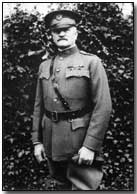Primary Documents - British Press Dispatch on the Battle of Belleau Wood, 5 June 1918
 Comprising two related actions,
firstly at Chateau-Thierry from 3-4 June and
then at Belleau Wood itself from 6-26 June, the Battle of Belleau Wood saw the recapture by U.S. forces
of the wood on the Metz-Paris road taken at the end of May by German Seventh
Army forces arriving at the Marne River around Chateau-Thierry and held by
four divisions as part of the German
Aisne offensive.
Comprising two related actions,
firstly at Chateau-Thierry from 3-4 June and
then at Belleau Wood itself from 6-26 June, the Battle of Belleau Wood saw the recapture by U.S. forces
of the wood on the Metz-Paris road taken at the end of May by German Seventh
Army forces arriving at the Marne River around Chateau-Thierry and held by
four divisions as part of the German
Aisne offensive.
Chateau-Thierry formed the tip of the German advance towards Paris, some 50 miles south-west. Defended by U.S. Second and Third Divisions dispatched at the behest of the French by AEF Commander-in-Chief John J. Pershing, the Americans launched a counter-attack on 3-4 June with the assistance of the French Tenth Colonial Division; together they succeeded in pushing the Germans back across the Marne.
Buoyed by success at Cantigny and now at Chateau-Thierry, General Bundy's Second Division forces followed up success at Chateau-Thierry two days later with the difficult exercise of capturing Belleau Wood. Casualties proved very heavy.
Stubbornly defended by the Germans, the wood was first taken by the Marines (and Third Infantry Brigade), then ceded back to the Germans - and again taken by the U.S. forces a total of six times before the Germans were finally expelled.
Reproduced below is a British press dispatch summarising the Americans' success in defending Chateau-Thierry at the start of June.
Click here to read Pershing's account of fighting at Belleau Wood. Click here to read an official French military report based on early fighting during the battle. Click here to read the text of an official French citation honouring the U.S. effort at Belleau Wood, issued on 8 December 1918. Click here to read the text of U.S. Secretary of the Navy Josephus Daniel's account of the battle.
British Press Dispatch on Battle of Belleau Wood, 5 June 1918
On May 31st, when the Germans were already in the outskirts of Chateau-Thierry, an American machine-gun unit was hurried thither in motor lorries. Chateau-Thierry lies on both banks of the Marne, which is spanned by a big bridge. A little to the northward a canal runs parallel to the river and is crossed by a smaller bridge.
The Americans had scarcely reached their quarters when news was received that the Germans had broken into the northern part of Chateau-Thierry, having made their way through the gap they had driven in our lines to the left of the town and then pouring along the streets to the bridge, intending to establish themselves firmly on the south bank and capture the town.
The American machine gunners and French colonials were thrown into Chateau-Thierry together. The Americans immediately took over the defence of the river bank, especially the approaches to the bridge.
Fighting with their habitual courage and using their guns with an accuracy which won the highest encomiums from the French, they brought the enemy to a standstill.
Already wavering under the American fire, the Germans were counter-attacked by the French colonials and driven from the town. They returned to the attack the next night and under cover of darkness crept into the town along the river bank and began to work their way through the streets toward the main bridge. At the same moment a tremendous artillery bombardment was opened upon the southern half of the town.
When within range of the machine guns the Germans advanced under the cover of clouds of thick white smoke from smoke bombs, in order to baffle the aim of the American gunners. A surprise, however, was in store for them.
They were already crossing the bridge, evidently believing themselves masters of both banks, when a thunderous explosion blew the centre of the bridge and a number of Germans with it into the river. Those who reached the southern bank were immediately captured.
In this battle in the streets, and again at night, the young American soldiers showed a courage and determination which aroused the admiration of their French colonial comrades.
With their machine guns they covered the withdrawal of troops across the bridge before its destruction, and although under severe fire themselves, kept all the approaches to the bank under a rain of bullets which nullified all the subsequent efforts of the enemy to cross the river.
Every attempt of the Germans to elude the vigilance of the Americans resulted in disaster.
During the last two days the enemy has renounced the occupation of the northern part of Chateau-Thierry, which the American machine guns have made untenable. It now belongs to No Man's Land, as since the destruction of the bridges, it is not worth while for the French to garrison it.
Against their casualties the Americans can set a much greater loss inflicted by their bullets on the enemy. They have borne their full part in what a French staff officer well qualified to judge described as one of the finest feats of the war.
Source: Source Records of the Great War, Vol. VI, ed. Charles F. Horne, National Alumni 1923
A "conchie" was slang used to refer to a conscientious objector.
- Did you know?
